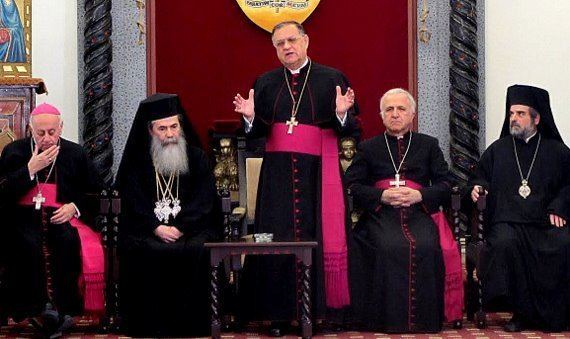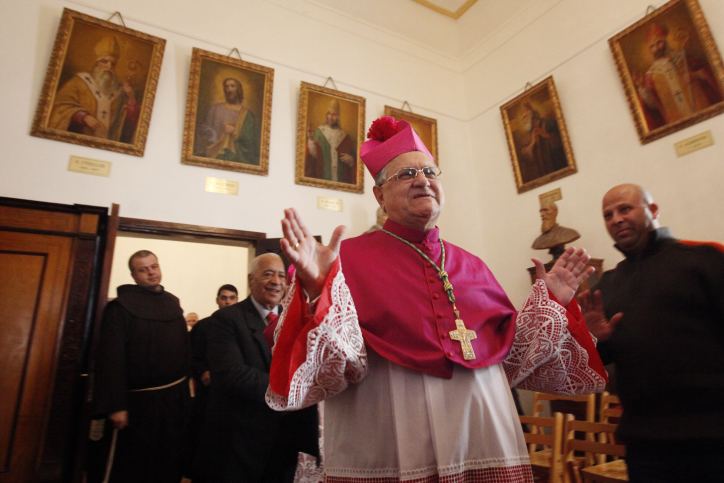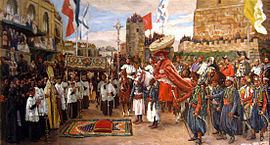Subdivisions Vicarates Parishes 66 | Population- Catholics (as of 2012)161,400 Secular priests 66 | |
 | ||
Country CyprusIsraelJordanPalestine Emeritus bishops | ||
Latin patriarchate of jerusalem
Latin Patriarch of Jerusalem (Latin: Patriarcha Hierosolymitanus Latinorum) is the title raising the rank of the see of the Latin Church Catholic Metropolitan Archbishop of Jerusalem.
Contents
- Latin patriarchate of jerusalem
- Background
- Latin Kingdom of Jerusalem
- Titular Latin Patriarchate of Jerusalem
- Modern Patriarchate of Jerusalem
- List of Latin Patriarchs of Jerusalem
- References
The Archdiocese of Jerusalem has jurisdiction over all 'Latin Church' Roman Catholics (not Eastern Catholics) in the Holy Land (Israel, the Palestinian Territories, and Jordan) as well as Cyprus. In Jerusalem, the Latin Catholic community is the largest Christian community, with some 4,500 people out of an estimated Christian population of about 11,000. Presently Sede vacante, the most recent Latin Patriarch of Jerusalem was Fouad Twal who resigned in 2016. The Latin Patriarch of Jerusalem also holds the office of Grand Prior of the Order of the Holy Sepulchre.

In the Catholic Church, the title Patriarch is customarily reserved to the highest ranking bishops of the Eastern Catholic Churches. The Patriarch of Jerusalem is one of four Archbishops of the Latin Church to be called a patriarch, the others being the Patriarchs of Venice, Lisbon and the East Indies (Goa (and Daman), India). These 'minor patriarchs' are Archbishops whose Metropolitan see has as a permanent privilege the honorific title of patriarch, comparable to a primatial see's title primate, yet more prestigious, and may be combined with such title. The honorary patriarchal titles Latin Patriarch of Constantinople, Alexandria and Antioch were abolished in 1964, other ones earlier. The title of Patriarch of Jerusalem is also used by the Eastern Orthodox Patriarch of Jerusalem, the Armenian Patriarch of Jerusalem, as well as, titularly, by the Melkite Patriarch.

Background
Jerusalem (in Latin also Hierosolyma) was one of the Apostles' original bishoprics. It was renamed Aelia Capitolina in 135 AD, again Jerusalem in 325. In 451 it was promoted as Patriarchal See. After 649, Pope Martin appointed John of Philadelphia (Amman) as Patriarchal vicar of Jerusalem to replace Sergius of Jaffa.

In 1054, the Great Schism split Christianity into the Eastern Orthodox Church—which consisted of the four Orthodox Christian Patriarchs of Antioch, Jerusalem, Constantinople and Alexandria—under the stewardship of Constantinople; and the Roman Catholic Church, which consisted of the Pope of Rome and virtually all of Western Christianity. Apart from the Maronites, most Christians in the Holy Land came under the jurisdiction of the Eastern Orthodox Patriarchate of Jerusalem.
Latin Kingdom of Jerusalem

In 1099, the Western Crusaders captured Jerusalem, set up the Kingdom of Jerusalem and established a Latin hierarchy under a Latin Patriarch (in communion with Rome), while expelling the Orthodox Patriarch. The Latin Patriarchate was divided into four archdioceses—their heads bearing the titles of Archbishop of Tyre, Archbishop of Caesarea, Archbishop of Nazareth and Archbishop of Petra—and a number of suffragan dioceses. The Latin Patriarch took over control of the Latin quarter of the city of Jerusalem (the Holy Sepulchre and the immediate surroundings) as his Metropolitan see, and had as his direct suffragans the bishops of Lydda-Ramla, Bethlehem, Hebron and Gaza, and the abbots of the Temple, Mount Sion and the Mount of Olives.

The Latin Patriarch resided in Jerusalem from 1099 to 1187, while Orthodox Patriarchs continued to be appointed, but resided in Constantinople. In 1187, the Crusaders were forced to flee Jerusalem, and the Latin Patriarchy moved to Acre (Akka), while the Orthodox Patriarch returned to Jerusalem. The Catholic Church continued to appoint residential Latin Patriarchs. The Crusader Kingdom of Jerusalem endured almost 200 years until the last vestiges of the Kingdom were conquered by the Muslim Mamluks in 1291, and the Latin hierarchy was effectively eliminated in the Levant.
With the fall of Acre, the Latin Patriarch moved to Cyprus in 1291.
Titular Latin Patriarchate of Jerusalem
From 1374, the Catholic Church continued to appoint titular Patriarchs of Jerusalem, who were based at the Basilica di San Lorenzo fuori le Mura in Rome.
In 1342, Pope Clement VI officially committed the care of the Holy Land to the Franciscans and the Franciscan Custos of the Holy Lands (The Grand Masters of the Order of the Holy Sepulchre) held the title ex officio under the Papal bull Gratiam agimus by Pope Clement VI, unless someone was specifically appointed to the honorary office.
Yet in 1570 it gained territories from the suppressed Archdiocese of Nicosia and Diocese of Paphos, and in 1571 it gained more territories from the suppressed Diocese of Limassol and Diocese of Famagosta, all in former Crusader kingdom Cyprus, which had fallen to the Ottoman Turks.
Modern Patriarchate of Jerusalem
A resident Latin Patriarch was re-established in 1847 by Pius IX, with Bishop Joseph Valerga being appointed to the office. Though officially superseding the Franciscans, Valerga was also the Grand Master of the Order. On Valerga's death in 1872, Vincent Braco was appointed, and following his death in 1889, the Ottoman Sultan authorised the re-establishment of a Latin hierarchy. The Grand Masters of the Order continued to be named as Latin Patriarchs until 1905.
The Co-Cathedral of the Most Holy Name of Jesus is the principal, or "mother" Church of the Latin Patriarchate, the church in which the Latin Patriarch of Jerusalem has his official chair (cathedra). However, the Basilica of the Holy Sepulchre has the title of cathedral of the patriarchate. The residence of the Patriarch is in the Old City, near the Co-Cathedral, while the seminary, which is responsible for the liturgical education, is in Beit Jala, a town 10 km south of Jerusalem, where it has been since 1936.
In 1987, Michel Sabbah became the first native Palestinian to be appointed Latin Patriarch. The Latin Patriarch of Jerusalem is now the diocesan archbishop of Latin Catholics of the Archdiocese of Jerusalem and has jurisdiction for all Latin Church Catholics in Israel, the Palestinian territories, Jordan and Cyprus.
The prerogatives of the Patriarch in his relation with government authorities overlap with the prerogatives of the Vatican Apostolic Nuncio to Israel, following the Fundamental Agreement between Israel and the Vatican signed on 30 December 1993, and Apostolic delegate to the Palestinian Authority.
In 2003, the Latin Patriarch was one of the signatories of the Statement regarding the Separation Wall by heads of Churches in Jerusalem, and in 2006, the Jerusalem Declaration on Christian Zionism, which repudiates Christian Zionism as inconsistent with Christian teaching. In 2008, Sabbah also signed the Kairos Palestine Document (published in 2009, after Sabbah term) against Israeli occupation.
In 2008, Fouad Twal from Jerusalem was appointed Patriarch to succeed Sabbah.
List of Latin Patriarchs of Jerusalem
Prior to the Great Schism, there were no separate Latin and Greek Orthodox Churches, and thus no separate Patriarchs. For Patriarchs of Jerusalem of the unified Church prior to the Schism, see Greek Orthodox Patriarch of Jerusalem.
Jerusalem was lost in 1187; seat of the Patriarch moved to Acre.
Acre lost in 1291; moved to Cyprus then Rome after 1374; titular patriarchs until 1847.
The Franciscan Custodian of the Holy Land held the title from 1342 to 1830 under the Papal bull Gratiam agimus by Pope Clement VI. The bull declared the Franciscans as the official custodians of the Holy Places in the name of the Catholic Church, "unless someone was specifically appointed in the honorary office".
During the Western Schism, the Patriarch was appointed by both Popes resulting in overlapping appointments.
Restoration of resident Latin Patriarchs of Jerusalem in 1847.
Latin patriarchate hierarchy re-established in 1889.
